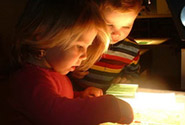Non Verbal Play with Nesting Glasses

In the video clips that follow, we observe three children, each about 18-months old, pretending to stir food using spoons and pans. Two adults, George (consultant) and the classroom teacher (off camera), tentatively begin an interaction with the children by asking a few questions; however their questions yield no responses from the children. Based on his observations, George shifts to a completely non-verbal strategy, engaging in parallel play beside the children. George’s goal is to enter the children’s play by offering some actions that are new to the children as provocations. George works to extend one child’s exploration by inventing an interesting action with the spoon and glass. The action of the glass spinning freely on the end of the spoon captures Shayna’s interest and she reaches toward George. George hopes Shayna will try to create the action by building her own spoon and glass combination, so he hands her a glass and resumes demonstrating the spinning motion. Shayna closely observes George’s action while placing the glass inside her pot. George speculates that Shayna may believe the action resides in the particular objects he is holding, so he hands Shayna his spoon and glass combination. In the complete Thinkprint, we observe the strategies that Shayna utilizes to imitate George spinning the glass on the spoon, ultimately translating this action into a much simpler form while still capturing the essence of George’s action.
This Thinkprint provides a clear example of "imitation", not as a process of absorbing and repeating what is witnessed but rather as an active process that involves understanding the purpose of a set of actions and then translating that purpose into a set of unique actions that are not identical to what is observed. The Thinkprint helps us appreciate the high level thinking children use when they imitate another person's actions. It also helps us understand the bond that can be created when individuals work together without talking.
Keywords: Ones, Containers, Children-Teacher, Communication, Imitation, Thinkprint
Length of Thinkprint: 20 text pages, 14 video subclips
Length of stand-alone master video clip: 5 minutes, 33 seconds
